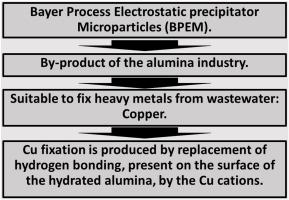Journal of Water Process Engineering ( IF 7 ) Pub Date : 2020-12-25 , DOI: 10.1016/j.jwpe.2020.101872 José Sancho-Gorostiaga , Antonio Bernardo-Sánchez , José Pedro Sancho-Martínez , Daniel Fernández-González , Luis Felipe Verdeja

|
The removal of heavy metals from natural, mining, or industrial ponds or water flows is a problem for metallurgical industries. The reason is that heavy metals represent a risk for the health of people living close to these industries. One of these heavy metals is copper, whose removal was widely studied using different aluminous materials (clays, zeolites, smectites or power plant ashes). In this manuscript, a different aluminous material is proposed to remove copper from water, the Bayer Process Electrostatic precipitator Microparticles (BPEM). The BPEM mainly consists of alpha alumina (min. 6.5 % and max. 53 %), aluminum hydrates (min. 12 % and max. 72 %) and intermediate or gamma alumina. The adsorption of Cu2+ by different BPEMs was studied using Nuclear Magnetic Resonance (NMR) technique. The NMR 1H and 27Al spectra were tested to identify the presence of oxides and hydroxides and their bonding structures, and how the spectra varied once the copper had been captured by the BPEMs. A huge attenuation of the 1H spectrum was found in all the studied BPEMs when copper is adsorbed. There does not seem to be any Cu2+ adsorbed related to 27Al, although some spectra show a slight attenuation of the corresponding peak, but not comparable with that observed in the case of the 1H. Thus, Cu fixation is produced by replacement of hydrogen bonding, present on the surface of the hydrated alumina, by the Cu cations.
中文翻译:

使用1 H和27 Al NMR光谱研究拜耳法静电除尘器微粒(BPEM)上铜的固定机理
从天然,采矿或工业池塘或水流中去除重金属是冶金工业的问题。原因是重金属对生活在这些行业附近的人们的健康构成了威胁。这些重金属之一是铜,已使用不同的铝质材料(粘土,沸石,绿土或发电厂的灰烬)对其进行了广泛的研究。在本手稿中,提出了一种不同的铝质材料以从水中去除铜,即拜耳法静电除尘器微粒(BPEM)。BPEM主要由α氧化铝(最小6.5%,最大53%),水合铝(最小12%,最大72%)以及中间或γ氧化铝组成。利用核磁共振(NMR)技术研究了不同BPEMs对Cu 2+的吸附。核磁共振测试了1 H和27 Al光谱,以确定氧化物和氢氧化物的存在及其键合结构,以及一旦BPEM捕获了铜后光谱如何变化。当吸附铜时,在所有研究的BPEM中都发现1 H光谱有很大的衰减。尽管一些光谱显示相应峰的衰减很小,但似乎没有任何与27 Al有关的Cu 2+吸附,但与1 H情况下观察到的峰不具有可比性。因此,通过置换产生Cu固定铜阳离子存在于水合氧化铝表面上的氢键的作用。



























 京公网安备 11010802027423号
京公网安备 11010802027423号